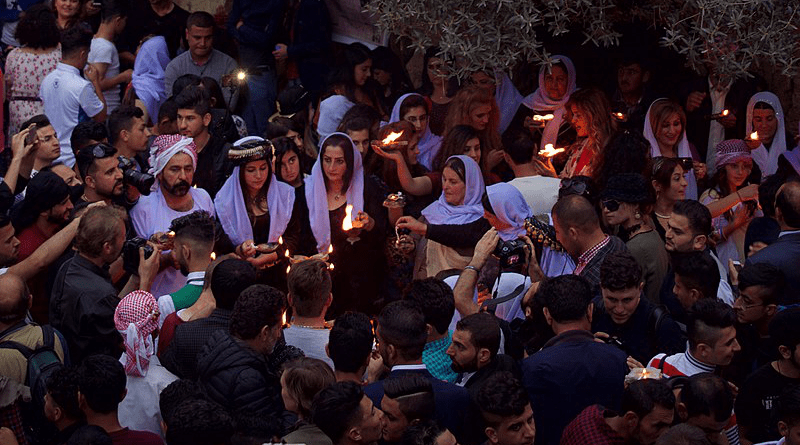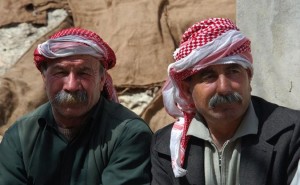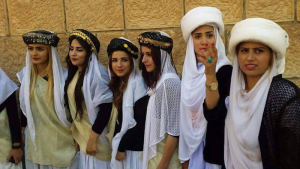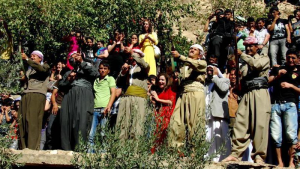Who Are The Yazidis? – Analysis
Yazidis (Yezidis) are an endogamous minority community who speak Kurmanji and are indigenous to Kurdistan – a geographical region in Western Asia that includes parts of Iraq, Syria, Turkey, and Iran. They are an ancient enigmatic Kurdish Mountain people and considered one of the oldest ethnicities in the Middle East.
Yezidism is the ethnic religion of the Yazidi people and is monotheistic in nature having roots in a pre-Zoroastrian Iranian faith. Since the spread of Islam began with the early Muslim conquests of the 7th – 8th centuries, Yazidis have faced persecution by Arabs, and later by Turks as their unorthodox religious practices have commonly been charged with heresy by Muslim clerics. They are referred to as an ethno-religious community, and one that is specially connected to the Kurdish people of Northern Iraq in the regions of Sheikhan, the Sinjar Mountain and the region of Lalish. They are ethno-religious community for whom religion and ethnicity are so strongly interconnected that we cannot separate one from the other. This is shown by the fact that religious identity is determined by the parents having to be pure Yazidis.
They hit mainstream news with the rise of the terrorist organisation Daesh back in 2014 when they seized the region in Northwest Iraq. We then witnessed heinous massacres and brutal crimes in the region. The worst of these was the genocide carried out against the Yezidi community, particularly in the Sinjar Mountain torturing them and brutally killing them, enslaving them, and selling their women and children in slave markets. This garnered massive international attention, but also, led to many of us to pose the question: “Who are the Yazidis?” and “What is the Yazidi religion?”
Origins
Sufis are Muslims who practise a more mystical path of devotion to God. Sufism is not exactly a separate sect of Islam but can refer to a variety of organisations that emphasise devotional piety and direct experience of God. Yezidism emerged in 12th century with the arrival of Sheikh Adi Ibn Musafir more commonly known simply as Sheikh Adi. He originally comes from what is now modern-day Lebanon and later studied in Baghdad under some of the most famous Sufi masters and most influential scholars in history, like Abd-al-Qadir Al-Jihani who is the founder of the Quadirriya Order and the two Al-Ghazali brothers Ahmad and Abu Hamid. It is believed he chose to lead a life of seclusion later in his life and he resettled in Lalish valley in the Kurdish mountains where he established an order of his own called Adawiyya described in medieval Arabic sources as Akrad Adawiyya (Adawiyya Kurds). This is where up to today we find the largest Yazidi population. Here he gathered a big following of local Kurds that eventually became known as Adyula Sufi Brotherhood and introduced his doctrines. This Sufi order, many scholars argue is the foundation of Yezidism. At the time the local Kurds were practising an old Iranian faith, which although may have been similar was separate from Zoroastrianism and was of pre-Zoroastrian origin.
It was very characteristic of Sufi Sheikhs and missionaries to be less tolerant or open towards local traditions in the region. They would often in their exercise adopt local practices of the older religion or tradition and in a way give it a new Islamic clothing to easily transition the population to a new Muslim identity. But after Sheikh Adi’s death in 1162 AD, his disciples and successors blended his doctrine and teachings with the local and ancient traditions. The geographical isolation of the region of Lalish together with the Sufi order eventually led to the gradual development away from its Sufi or Islamic roots into its completely own traditions. Therefore, Yazidis use many terms, images, symbols of Sufi pre-Islamic mythology, symbology, rituals, festivals, and traditions. Yezidism was then embraced by many Kurdish tribes and emirates and has become the official religion of numerous Kurdish emirates and principalities including Domboli, Mahmudi, Bohtan and the emirates of Kilis.
Yezidis got to develop their own internal religious and political administrative apparatus around the 14th century in areas they inhabited. Their territory consisted of seven divided regions, each having its own “Cincaq”, more commonly known as “Tawus” among their communities. Cincaqs are bronze peacock idols which serve as symbols to signify power for each administrative region, namely:
1 – Tawisa Enzel: Lalish
2 – Tawisa Singale: Shingal Region
3 – Tawisa Hekkari / Zozana: Historical region of Hakkari
4 – Tawisa Welat Xalta: Region around Siirt
5 – Twisa Helebe: Alepo and Afrin
6 – Twisa Tewreze: The city of Tabriz in today’s Iran
7 – Tawisa Misqofa (Moscow): It was renamed from Tawisa Serhede after the exodus of the Yazidis from Serhed to the Russian Empire.
Historically, the Yazidis primarily lived in communities in Iraq, Turkey, and Syria. They also had significant numbers in Armenia and Georgia. Traditionally, the majority lived in isolation in their villages in Iraq. However, predicaments since the end of 20th century that involved the destruction of their villages by Saddam’s regime, and the Baathists who created collective villages for them and forced them to relocate from their historical villages. This culminated in a significant demographic shift in these areas as well as mass emigration which makes it difficult to make an estimate of the size of their population.
Early relations with the Middle East
The Yazidis’ ever-growing large influential power caused them at the time to be perceived as a menacing group by the neighbouring Muslims which intensified the Yazidi-Muslim conflict that would last for centuries to come. The Yazidis became more vulnerable and were subject to brutal persecution by the Arabs, Persians, Turks, and Sunni Kurds. The most significant early expeditions against the Yazidis took place in 1246, when the Yazidi leader Sheikh Hassan Ibn Adi was killed by Badr Ad-Din Lulu and in 1414, when Sunni Kurdish tribes joined armies and ransacked Lalish.
During these conflicts many important Yazidi chiefs were forced to convert to Islam which resulted in the gradual decline of Yazidi power from the 15th century. Despite their harsh circumstances the Yazidis managed to establish alliances with neighbouring powers namely, Qara Yusuf of Kara Qoyunlu and Uzun Hassan. They thrived under the reign of Saladin – they served as troops, ambassadors and were offered lands to govern.
The Ottoman Period
Yazidis have for most of the time received less than favourable treatment and have for a large portion of their history been under the rule of Muslim empires and kingdoms. This intermittent persecution and oppression by the Muslims can be traced as in so many other cases to social factors. During the Ottoman era, for example, when the Ottomans conquered Kurdish regions in the early 16th century and installed their own governors in Diyarkebir, Urfa, Shingal and Mosul, the Yazidis then lived as semi-independent entities under their empire. They were well tolerated by the Turks usually when they could be beneficial to the Ottoman state and to the Sultan by serving in the army. Yazidi leaders occupied many important positions within the provincial Ottoman system and were appointed as governors as far as Tikrit and Kerek. They also participated in trade, commerce, and river transportation of their territory through contact with other ethnicities and religions.
However, towards the end of the 19th century, Ottoman policies and attitudes towards the Yazidis took a different dimension under the reign of Abdulhamid 2nd, under whose regime the Muslim identity became fundamental for the Sultan’s perception of loyalty among his subjects. Conversion to Islam to ensure their political loyalty became essential in the agenda of Abdulhamid’s government. One of the steps taken to convert them was conscription. Thereafter, Yazidis became subject to persecution and oppression for, according to the Sultan, refusing to pay their taxes and joining the army. They suffered violence to the extreme due to their lack of cooperation from Omar Wehbi Pasha who had been sent to Mosul by the Sultan on a mission that entailed institutionalisation of a conscription system, collection of taxes, resettlements of tribes, and crushing local tribal rebellion.
Around 500 Yazidis died in the conflict of 1892, Lalish was forced to convert into a madrasa, sacred objects of the Yazidis were confiscated, mosques built in Yazidi villages and the Yazidi leader Mir Mirza Beg was pressurised into converting to Islam. However, contrary to the Ottoman’s expectations, this only provoked a widespread religious revival in motion at Shingal. Yazidi refugees fleeing from Sheikhan took shelter in Shingal Mountain and their stories of all the atrocities that took place in Sheikhan still live to tell the tale.
Identity
Kurdish identity keeps springing up endlessly when conducting research on Yazidis. The name “Yazidi” is contested and there is no consensus where it came from and why it was applied to these people. Some think it is connected to the Persian word “Yazad” which means “divine being”, others think its origins go back to the second Umayyad Caliph Yazid Ibn Mu’awiya whom the group that became Yazidis are said to have sympathised with. Some Yazidis speak Arabic as their mother tongue, but the majority mostly speak the Northern Kurdish dialect Kurmanji. Their cultural practices are observed in Kurmanji which is used by almost all the orally transmitted religious traditions of the Yazidis. Despite this, their origin is still a matter of dispute among scholars, even among the Kurdish community itself whether they are ethnically Kurds or form a distinct ethnic group.
Most of the Yazidis say they are the original Kurds and some nationalists claim that Yezidism is the original Kurdish religion. However, many still contest and reject the Kurdish identity insisting that being a Yazidi constitutes its own ethnicity. To be Yazidi is to be born of Yazidi parents because Yazidis only intermarry with other Yazidis; those who marry non-Yazidis are expelled from their community and no longer allowed to call themselves Yazidis. They’re considered to have converted to the religion of their spouses.
The modern younger generation of Yazidis identify themselves as a subset of the Kurdish people while others identify as a separate ethno-religious group. In Armenia and in Iraq they are recognised as a distinct group. Yazidis according to the Armenian anthropologist Levon Abrahamian, believe that Muslim Kurds betrayed Yezidism by converting to Islam, while Yazidis despite the pressures of the oppressor remained faithful to the religion of their ancestors.
Yazidis are considered the ethnic Kurds or the “original Kurds” in the autonomous Kurdistan Region of Iraq. Vian Dakhil the sole Yazidi Parliamentarian representative was also opposed to any move to separate Yazidis from Kurds. The president of the Yazidi National Union Aziz Tomoyan argues that the term Yazidi is used to describe “a nation and their language is called “Ezdiki”, and their religion is Sharfadin”. In the opinion of researcher Victoria Arakelova, “Yezidism is a unique phenomenon, one of the most remarkable illustrations of ethno-religious identity, centred on a religion the Yazidis call Sharfadin. And therefore, it’s quite legitimate to speak of the unity of both the Yazidi religious identity and Yazidi ethnicity”
Religion
The idea of non-Abrahamic religion, like that of the Yazidis with roots all the way back to ancient Mesopotamia sounds less intriguing. This became headline news when the UN declared ISIS were committing genocide against this religion due to their belief that the Yazidis worshiped the devil. We could easily sense this is a syncretic religion due to the peacock angel, fire worship and strict ban on marrying outside the faith. Yazidi religion appears to be a blended mix of Abrahamic and non-Abrahamic faiths. That being said, they are strictly non-Abrahamic but there is lots of Islamic influence in their language especially, their more esoteric thinking which seems to borrow heavily from the Sufi tradition of Islamic mysticism. However, that is where the similarities end. Their myths about the foundations of the universe seem to have more links with the religious beliefs of ancient Mesopotamia and Iran as well as Zoroastrianism from which they borrowed the Zoroastrian reverence of fire.
It is a hierarchical religion led by a Prince or Emir, and religious Sheikh authority. It follows a strict caste system, like that in Hinduism, that divides them into different castes: The lower caste which makes the majority are known as “Murids”, above them are the “Pirs” or Elders who function as spiritual guides and religious clergy, and lastly, the highest caste who are the “Shiekhs” or Masters. These have a rather similar role to the “Pirs” but in a more exalted manner. They are thought to have healing powers for example, the same terms are recognised in Sufism and Sufi terminology as we find the same words used in the hierarchy of the Sufi order and generally in the Sufi practice. Murid in Sufism denotes a student of a Master also, known as a Sheikh. Pirs is used as a name for the leader of a certain Sufi order.
Yezidism can be characterised primarily as a religion of orthopraxy rather than orthodoxy in the sense that they put more emphasis on cultural and traditional practices and taboos rather than having to follow a theological doctrine. The caste hierarchy and the ethnic unity of the Yazidi people is essential to their being – Intermarriage between castes is not permitted; different castes can mix together but can never marry. They do not accept any converts and marrying outside the faith is punished by expulsion from the community or even the death penalty. The role of the Murid or the Sheikh is, therefore, hereditary. Religion and ethnicity go hand in hand, and this comes from the Yazidis’ obsession with purity.
They have internalised some Zoroastrianism about the elements of fire, water, air, and earth, and have taboos about mixing the elements. Actions like spitting on the ground or into a fire are considered very much off-limits. They share the mythological background of the Abrahamic faiths, and they trace their race to Adam – the first man. They believe in their creation myth that the world is populated by descendants of Adam and Eve, but the Yazidis are the children of Adam alone and thus separate from the rest of humanity. They are the only race to be made from the reproductive fluids of Adam. In fact, they often hold that their people are descendants from a miraculously born son of Adam called Shehid Ibn Jerr and from that point on, this religion is being traced through the Babylonian, Sumerian and Mithraic cultures.
Yezidism is primarily an oral religious tradition which means they passed down their sacred history and teachings through generations by word of mouth over the course of centuries. They do not have any sacred books or chronical collection of texts to refer to as a direct source, like the Bible or the Quran that records official versions of their myths. The last published texts were in 14th century, and there were not many of them. There is no creed statement of orthodox belief in Yezidism. This also, means there are many different, often competing understandings of basic tenets and elements of the religion and different ways in how its practitioners understand and relate to it. There is no proclamation of faith that Yazidis affirm and no unity in terms of performing rites or prayers or how these are to be implemented.
Yezidism is described as a monotheistic religion much like the Christians, Muslims, and Zoroastrians because they believe in one Almighty God who is sometimes called “Hua” – the Kurdish name for God, Xwede, or even Allah. Arguably then this is the same the God as the Abrahamic faiths as Yezidsm share many of the mythological basics of these religions. But this one God in Yezidism is so transcendent, he is uninterested in earthly or worldly affairs and does not interface with humans directly. In their religious practice God has assigned the task of delegating to a pantheon of seven angels. He focuses on “heavenly affairs” and leaves the ruling or governing of the world to his seven angels also, called seven mysteries or seven emanations.
These are called “Haft Sur” or the “Heftad”, and the holiest and most powerful of these is “Malak Tawus” – also, known as the Peacock Angel. He is the leader of the seven angels and has been given the responsibility to carry out God’s will on earth. Malak Tawus has thus become the most prominent and important symbol for Yezidism as we can see in many logos and symbols that represent this religion. These angels are also, thought to adopt a human form almost like an avatar in Hindu tradition, and have done so throughout history. These incarnations are known as “Khass” as an example, some Yazidis believe that Jesus and the early Muslim theologian and mystic Hasan Al-Basri are two examples of these Khass. They also, use the name “Shaytan” for Malak Tawus and this is where their misfortune lies as the name Shaytan is the name of the devil in the Quran. Consequently, they spent centuries being called devil worshipers just for the name.
This is because according to some versions of the Yazidi creation mythology God created the seven angels from his own light as if lighting the seven candles from one chief amongst them Malak Tawus – the Peacock Angel who is considered to be a manifestation of God and acts as a separate agent in the world to be his custodian and become an intermediary between him and humans. Malak Tawus is the key actor in some of foundational myths of Yezidism – that the origins of humanity itself Yazidis believe directly descended from the first man on earth Adam, and Malak Tawus was with him in paradise at the beginning of humanity which is a reminder of the book of Genesis when Adam eats the forbidden fruit, and he gets expelled from the Garden of Eden. This is portrayed as a catastrophe in Genesis brought on by the evil snake. But the story is very different in the Yazidi mythology. Here it is said that God put Adam in paradise, but Malak Tawus was with him and convinced him to leave. Some versions say that God forbade him from eating grain and the Peacock Angel was concerned that Adam will not grow and flourish without it and he successfully convinced him to eat it. Rather than a catastrophe that dooms humanity this is viewed as God’s divine will. Therefore, Malak Tawus is holy – an emanation of God who plays a central role in Yezidism.
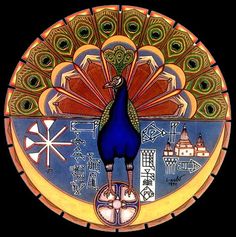
Their Muslim and Christian neighbours have for centuries confused this angel with the evil character Satan and have accused them of being devil worshippers. This is related to a different theory of the Peacock Angel being asked by God to bow to the first man Adam to which he refused because he did not want to bow to anyone else but God. This was done out of love for God and thus was given the highest position that made him exalt to the most superior angel. This is almost identical to the story of Satan in the Bible or Iblis in the Quran as he was also, asked to bow to Adam to which he refused. But he then got punished and was expelled from Heaven for disobeying God’s order. As a result, Christians and Muslims identify Malak Tawus of the Yazidis with the devil or Lucifer of Abrahamic faiths.
They deny being devil worshipers but being labelled as such does not help their reputation. In their mythology there is no all-encompassing evil being comparable to Satan in Christianity and Iblis in Islam. Nevertheless, this always has been a sore spot for Muslim empires and throughout history they used this stereotype to justify brutal violence and against them. Leading scholars of Yezidism report that the names of Satan or Iblis are so offensive to these people, and it is even forbidden to pronounce them in their religion. Just like their neighbours they believe in heaven and hell. But there is a conflicting belief as some Yazidis believe hell does not exist because Malak Tawus extinguished all its fires.
Another prominent symbol for them is the sun which represents God and his creative power and as a result, just like their Muslim neighbours they pray facing the sun and at sunrise and sunset. However, unlike Muslims there is no code of practice for daily prayers, and they are not mandatory for the Yazidis.
They also, believe more in Reincarnation after death rather than the more common monotheistic concept of heaven and hell. They believe that the human body passes through another human body after death and they could somehow, secure some sort of favourable rebirth based on how they lived. Another belief is that holy beings can assume the likeness of other humans, as an example Jesus and the Virgin Mary and the Prophet Mohmmad are holy beings as well as being the most prominent individuals in our history.
They celebrate festivals around the year, like the Yazidi new year which is celebrated in April. But the most important festival of the year is the one known as “Jamiyya” or the feast of the assembly (the festival of assembly) which takes place over the course of 7 days. This is celebrated in honour of Sheikh Adi and during this Yazidis make a pilgrimage to Sheikh Adi’s grave in Lalish where they get together as a community to perform religious rituals, listen to “Qowals” who are a class of Yazidis reciting religious hymns and stories.
Oral performance of sacred hymns plays a big part in the teaching of Yezidism as mentioned before this is an oral religion and the Yazidis transmitted much of their ancient history and teachings through these sacred hymns. The Quowals memorise and perform these hymns traditionally accompanied with the flute and tambourine. Some rituals cannot be performed without the presence of the Quowals. These act as the living memory of the Yazidi community preserving their culture for generations by passing hymns from father to son. Despite this long history of orality and performance Yezidism has increasingly become more spiritual. Professor Christine Robins reports Yazidis started in the 1970s to write down and publish collections of their hymns. This has led the community to form a canon of sacred texts which in a way demonstrates this religion has changed over time…
Demographics
Syria
Beside Iraq and Iran Yazidis exist in Syria where they live primarily in two communities one in Al-Jazira region and the other in the Kurd-Dagh. Although half of the community have emigrated since the 80s, Syria has seen the arrival of as many as 50.000 Yazidi refugees from the Iraqi war.
Georgia / Armenia
Their population has been dwindling in Georgia and Armenia since the 1990s mostly due to economic migration to Russia and Western Europe. Yazidis celebrated the opening of Sultan Ezid Temple and cultural centre in 2015 in Georgia. This is the third such temple in the world after those in Armenia and Iraqi Kurdistan.
Russia
In Russia the largest Yazidi population is concentrated mainly in Moscow and St Petersburg. Outside these two major metropolitan areas Yazidis are very much scattered throughout Russia.
Turkey
Some of the indigenous Yazidi population of Turkey have fled the country during 19th century for present-day Armenia and Georgia. The Yazidi community in Turkey has quickly declined during 20th century. They have mostly emigrated to Europe, particularly Germany – those who have remained live in their former Turkish stronghold of Tur Abdin.
Western Europe
Mass emigration has led to the establishment of huge Yazidi diaspora communities in Western Europe particularly in Germany (mentioned above) which has a Yazidi population of around 200.000. Most are from Turkey and more recently from Iraq living in the North Rhine-Westphalia region and Lower Saxony. Since 2008 Sweden has also seen a considerable increase in its Yazidi emigrant community which around 2010 has increased to around 4000, and a smaller community exists in the Netherlands. We find other Yazidi diaspora groups residing in Belgium, France, Switzerland, Denmark, the United Kingdom and Australia.
North America
Many Yazidis have settled in the United States of America and Canada. Many of them now live in Lincoln, Nebraska, and in Houston Texas. It is estimated that the largest settlement is in Nebraska. Around 10.000 Yazidis in the US were received under the Refugee Settlement program of the 1990s. Many of them now work as translators for the US military.
Conclusion
The Yazidi population currently in the world is not known but it is estimated to be around 2 million. The largest population that lived in the Sinjar Mountain was severely minimised in 2014 due the genocide inflicted by ISIS that caused a total exodus. Yezidism, therefore, has a significant diaspora community around the world. This has led to questions regarding their integration and understanding their religion by new societies. A prime example of this is the fact that Yazidis have not traditionally been allowed to learn how to read and write except those in the highest caste are entitled to an education – the Sheikh caste. The reason behind this is to keep the religious teachings secret and confined to the lineage of the Sheikhs and the religious clergy to avoid being educated in the Islamic folds. However, what with modern thinking this doctrine has been compromised in recent years as Yazidis entered Europe especially, in diaspora communities to allow some integration. Although, Yezidism has its origins in a Sufi order (The Adawiyya of Sheikh Adi) it has throughout history developed into its own unique traditions that are separate from the religion of Islam.
There is widespread trauma in their community over the long history of persecution they have endured. The Ottoman empire targeted them in the 1800s with forced conversions, the Iraqi dictator Saddam Hussein persecuted them in the 1970s displacing them from their homes and destroying their shrines, Al-Qaeda murdered hundreds in 2007, and most recently in 2014 they had to face heinous massacres and sexual slavery at the hands of the terrorist group ISIS. It was total genocide – thousands were brutally murdered, and others displaced and still live in refugee camps. They were persecuted over centuries and suffered many genocides and all for the confusion and misunderstanding of the name “Shaytan”!!
*About the author: Souad Khattar, MPhil in International Relations & Geo-Politics, London, United Kingdom
References:
Documentary: Eszter Spat – “Following the Peacock”
Research Articles :
Majid Ali – “The Reformation and Development of Yazidi Identity from a Theoretical and Historical Perspectives”
Emre Basci – “Yazidis: A commmunity scattered in between geographies and its current immigration experience”
Majid Hassan Ali – “Cultural Heritage Destruction during the Islamic State Genocide against the Yazidis”
Books :
Eszter Spat – “The Yezidis” Burgul Acikyildiz – “The Yezidis: The History of a Community, Culture and Religion”

